Name
Szczecin. Pronounced like "Shtshechin". The town is also still famous under its old German name Stettin. The name Stetin already appeared as early as 1133, the Latin name is simply Stetinum. There are several theories about the origin of the name - one of them stating that the name might derive from the Slavic word szczyt, which translates as "summit" but also as a long shield.
Location

| ||
| Szczecin |
Szczecin lies in the very north-western corner of Poland and is only around 120 km away from Berlin (and some 10 km away from the Polish-German border). The larger part of the town stretches along the left (west) bank of the river Odra, but some parts of the old town and some newer districts occupy the river islets and the east bank. North of the town starts the Szczecin Lagoon, which marks the beginning of the Odra estuary - the Baltic Sea is very close. The river Odra around Szczecin is split into several creeks, forming numerous more or less large islets even within the town. Right in the south starts the long Lower Oder Valley National Park.
Culturally and historically, Szczecin is known as the centre of Pomorze Zachodnie (Farther Pomerania, German: Hinterpommern).
Population
The town has around 420,000 inhabitants, which makes Szczecin the seventh-largest town of Poland and by far the largest town in Farther Pomerania. Already in 1939, some 382,000 people lived here, but the number dropped drastically to 180,000 in 1950 - mainly because every German was expelled.
Orientation
Depending on where you enter the town, the first thing you might see is endless suburbs and several residential and industrial areas. The entire town occupies quite a large area. The centre itself starts at the west bank of the West Odra, opposite the long island Lastadie (Łasztownia). The old town sits some dozen metres above the river and its valley.
Rather unusual for a European town, there's no real central square. Instead of that, there are many small parks, wide boulevards and some large roundabouts. Not many places remind the visitor that Szczecin was an important town in medieval Germany and Poland - when looking at the street grid and many buildings, it rather resembles places like Paris (en miniature of course). This is no coincidence - Paris as well as Szczecin were redesigned by the same urban architect during the 19th century.
Thanks to the numerous churches, the centre itself is clearly defined. It mainly stretches between the West Odra, Grunwaldzki Square (formerly known as Emperor Wilhelm Square) and Zwycięstwa Square. Train station and the adjacent bus terminal can be found next to the river at the southern tip of the old town. The oldest part of the town lies close to the river as well north of the wide Trasa Zamkowa (Castle street?) around the old town hall and the Pomeranian Castle.
A walk through the old town gives an idea of how much the town must have suffered during the wars - all that is left from the old town is some larger buildings here and there. Almost all of those buildings needed to be rebuilt almost from a scratch. There are not many smaller old buildings left. Apart from modern architecture, the often bulky looking northern German architecture is predominant. This means a lot of art noveau and giant red brick buildings - the same kind that can be found in Hamburg, Berlin and many other large cities in Northern Germany and Poland.
History
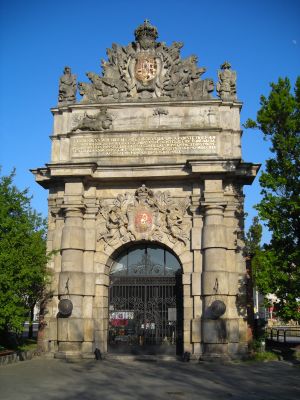
| ||
| The Berlin Gate (today known as Port Gate) |
The area was once the main land of an East Germanic tribe called the Rugians, but they were driven out by a Western Slavic tribe during the 8th century. The hills along the west bank of the river Odra offered a great location for building a settlement. At first, a simple fort was built. This was later replaced by a fortress. Pomerania including Szczecin was eventually conquered by Poland during the 10th century. After that, the town could maintain a certain level of autonomy, but it remained a pagan area - until it was baptised by German clerics. Around the year 1200, Szczecin was a Danish town for a longer period of time.
Later on, more and more Germans settled down in Pomerania including Szczecin, which was gradually growing stronger and more powerful. A port was built, which enabled the town to join the mighty Hanseatic League in 1278. Its position as the centre of Pomerania remained unchallenged, and so Szczecin continue to thrive. However, as with countless other towns in Europe, progress was slowed down by outbreaks of pest epidemics, mainly during the 15th century, and other calamities.
For a long time the town remained untouched during the Thirty Years' War. But in 1630 it was finally occupied by Swedish troops. In 1676, Brandenburg (present-day Germany) besieged the town for two years. But only one year after the successful siege, the Brandenburgers had to leave again. During the devastating Nordic Wars, Szczecin was even besieged by Russia. In 1720, the town finally fell to Prussia - this time for a much longer period of time.
Now called Stettin, the town boomed. Apart from a small visit by Napoleon's army, it remained peaceful for a long time. In 1843, the railway connection to Berlin was opened. The port developed as well - during the first half of the 20th century, it was Germany's third most important port after Hamburg and Bremen. But in 1944, Stettin fell victim to massive allied air raids. 90% of the old town and 70% of the entire town were completely destroyed. In July 1945, after the victory over Nazi Germany, Szczecin was put under Polish administration by the Soviet Union. As a direct result, around 100,000 German inhabitants had to leave the town virtually over night.
Szczecin's role as an important port city didn't change in Poland. For a while, the town's port was considered to be the biggest in the Baltic Sea area. But Szczecin was also to be become a centre of resistance against the communist government and was one of the birth places of the union Solidarność. In 1985, the University of Szczecin started to attract students from all over the country. After the rapid change in Poland's political system around 1990, Szczecin, heavily relying on its industry faced massive problems, since many of the large factories proved to be unprofitable. But compared to the 1980ies, many things have changed for the better. Since Poland joined the EU, new fundings became available to support the town preserving its cultural and historical heritage.
Getting there / transportation
Szczecin has excellent railroad connections. To Berlin, it's only two hours by train (it takes around the same by car, since there's a autobahn between the German capital and Szczecin). Several trains are direct trains, others require to change trains in Angermünde (Germany). Tickets from the so-called Verkehrsverbund Berlin-Brandenburg (Transport Network of the capital and its surroundings) can be used - the fare with that ticket is € 16.
There are many other train connections - to →Warsaw (around 6 hrs), →Wrocław (Breslau) (5 hrs) via →Poznań (2½ hrs), Lübeck (5 hrs), Zakopane (14 hrs), Krakau (11 hrs) and even straight to Amsterdam (9 hrs). Additionally, international bus connections start from the bus terminal next to the train station.
The nicest way to get to the Baltic Sea is by boat, but availability depends on the season. There are also slow trains to Swinoujscie at the coast - it takes almost two hours with them.
Everything in Szczecin is within walking distance, but trams are very convenient as well.
As almost every other town in Poland, Szczecin has suffered a lot during the Second World War. There's not much left from the glorious Prussian-dominated town with its history as a member of the Hanseatic League. Some old buildings can be seen here and there in the old town, always interrupted by more or less attractive newer architecture. There's no larger architectural ensemble left. But west of the old town starts a beautiful, well preserved art noveau residential area built some 100 years ago. The following selection of sights is incomplete but shall give a rough overview.
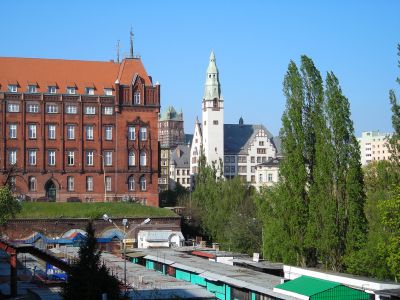
| ||
| Socialist style market square, Red Town Hall and an old school building |
The best way to get an idea of the town is a view from the other side of the river Odra. The panorama includes several church towers, but also huge red brick buildings - especially the post office and the Red Town Hall on vibrant Dworcowa street, which leads from the train station right to the old town. Below the Red Town Hall lies a small park with an interesting fountain.
Post office and the town hall were obviously built during the same period - around the year 1875. By the way, it's highly recommended to have a look inside the post office - there are not many counter halls in Europe's post office that look nicer (well, many look similarly beautiful, though). A look inside the town hall - if granted - is worth the effort as well.
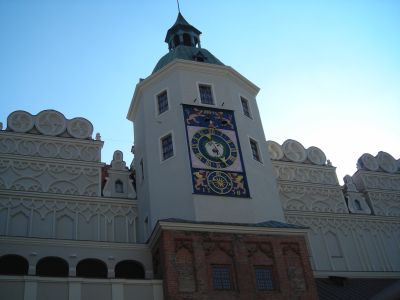
| ||
| Inner courtyard of the Pomeranian castle |
A real eyecatcher in Szczecin's panorama is the snow-white Zamek Książąt Pomorskich (Castle of the Pomeranian dukes), towering over the city on the top of a small hill. The castle was once seat of the mighty Gryfici (House of Pomerania) dynasty. Before, the place was occupied by a Slavic pagan temple. The rulers started to build the castle around the 14th century, but wide parts were added or changed during the centuries to come. Unfortunately, the castle was not spared from almost complete destruction during the air raids at the end of World War II, but the town put much effort in restoring the structure - and the result is definitely worth it. The large inner courtyard with its clock tower (see picture; the baroque clock was added in 1693) is now sometimes used for cultural events such as classic concerts. There's also a museum, an opera, a restaurant and some cultural institutions inside the castle
Parallel to the large courtyard runs the much smaller Mint Court with a large bell tower on one end, which can be climbed (for a small entrance fee). However, the information booth selling the tickets (inside one of the wings of the Mint Court) seems to open sporadically - we were sent there to get a ticket, but no one was there. As of spring 2007, the reconstruction of the entire castle was almost finished - but not completed. The area surrounding the castle makes a nice walk as well.
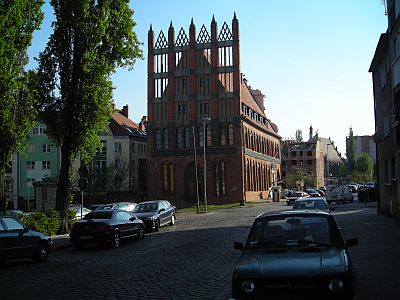
| ||
| The old, somewhat warped Old Town Hall |
Below the castle to the south and near the river Odra stands the Stary Ratusz (Old Town Hall), which looks a little bit lost and lonesome next to all of those newer apartment buildings. Obviously the building is warped - during the centuries, parts of the structure subsided a good deal. The old town hall strongly resembles the architecture of the Hanseatic League - similar buildings can be found in Bremen, Lübeck, Stralsund, →Riga etc. The basement dates back to the 13th century and is the oldest remaining part. The rest is a (well done) reproduction of the city hall as it looked like in the 15th century. The gothic building houses the city's historical museum and, in the basement, a posh restaurant. The square in front of the old town hall, or better the buildings along the square, are under reconstruction - here, the very old Szczecin is being rebuilt. Large parts are already finished and look nice. Coincidentally, the new old buildings are mainly used as cafés and restaurants - catering flocks of day-trippers from Germany. However - this open air museum like part is worth a look.
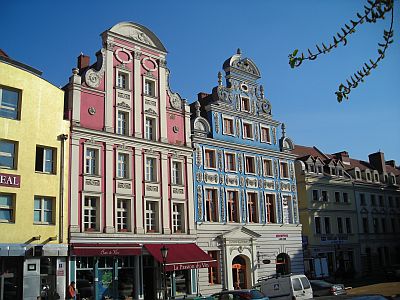
| ||
| Recently rebuilt old buildings near the Old Town Hall |
Mentioning all the large churches in Szczecin would take to much space. There are the Arch Cathedral (also St Jacob Church), the Garrison Church St Adalbert, the Holy Heart of Jesus Church, St Peter & Paul Church, St John Church and so on and so forth. Szczecin has always been a protestant stronghold, but this of course has changed in strictly catholic Poland. Many of the churches are very interesting - architecturally as well as historically. However, visitors familiar with Berlin or Hamburg won't find many surprises here.
I can't remember much from my first visit to Szczecin in 1986 - but I remember that the town didn't make a very good impression. This changed when I went there again in 2007 - a lot has changed and now the town is worth a trip.
The above-mentioned Lower Oder Valley National Park south of Szczecin, the Szczecin Lagoon and the Baltic Sea - the Szczecin Bay to be exactly - are all worth a longer visit. The widely ramified Odra river system with its unique flora and fauna offers a for Europe rare scenery.
After running around for a quite a while, looking for something that might be a hotel, I ended up in a hotel chain - Ibis. This can be found right behind the Red Town Hall in Dworcowa street, making it a very convenient location. The hotel offers the usual 3 stars hotel standard in a boring, new building and the usual single room price of 189 Zl. There seem to be some other, older hotels in town, but it's not easy to find them without consulting the tourist information, which is on the other side of the same street as the Ibis is in.
- www.city.szczecin.pl: Official website of the town - including an English version and worth a look.
- www.czejarek.pl/stettin/: Interesting old post cards from Stettin in chronological order. Includes an English version.
Do you have or do you know a good website about Szczecin? Don't hesitate, let me know! After checking it, I would love to add it to the link list. You can submit a link by using the →contact form. Note that commercial websites will be treated differently.
©2024 Europe-East.com

 Albania
Albania Poland
Poland